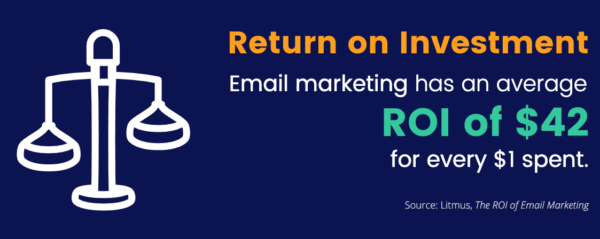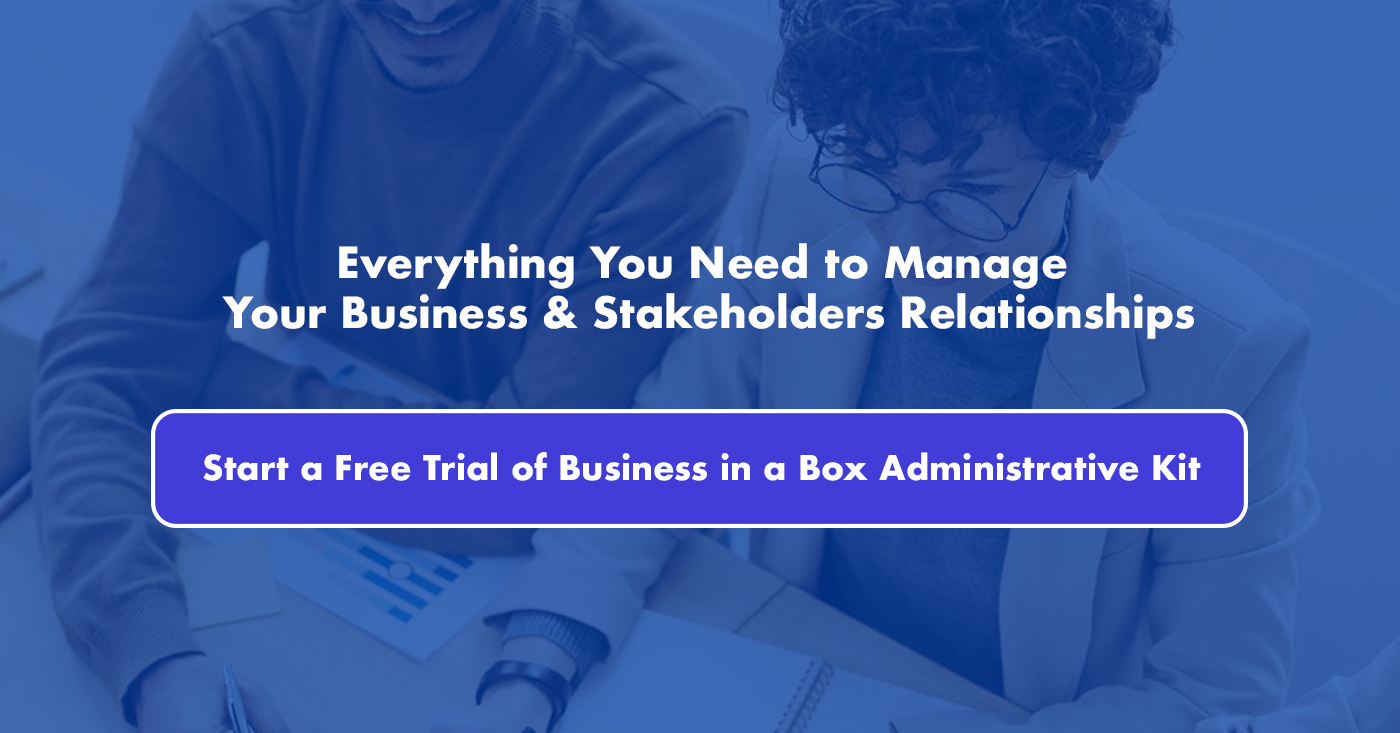
A common thread through just about every industry is the effectiveness of email marketing. When used right, email marketing for administrative services can directly engage your audience and even help you get more out of the rest of your marketing efforts too.
Email is an effective, low-investment way to market your business support services, and getting started is simple. We’ll give you a basic rundown of why email marketing is important for growing your business, how to incorporate it into your marketing strategy, and the key best practices to keep in mind along the way.
Does email marketing really work?
In short, yes.
Email marketing has the highest return on investment of any digital marketing tool — on average; it generates $42 for every $1 spent. Consider these stats on email marketing:
- Email is shown to be 40 times more effective at landing new customers than social media channels, with a massive conversion rate of 66%.
- With email marketing, your message is five times more likely to be seen than content shared on social media.
- Consumer preferences are on your side — 72% of people prefer receiving business-related content by email over other options.
Not only is email a highly effective strategy for capturing and keeping clients, it also rates as one of the easiest to manage. That means more bang for your marketing buck and less of a learning curve when first starting out.

Email marketing is the most effective and least difficult marketing strategy, according to marketers worldwide.
Using email marketing in your digital strategy
Email marketing also serves as the cornerstone to propel a larger digital strategy. You can use email to stay in touch with past clients and seek out people who might need your services in the future — which means it’s useful for acquiring new customers and keeping existing ones.
But email marketing isn’t just about making a sales pitch or sending an obligatory “happy holidays” message once a year. There are plenty of ways to use email to keep clients engaged year-round.
You can send messages to promote blog posts, publicize contests, and announce new products directly to the people most likely interested. Email also makes it easy to tailor campaigns to individuals or groups of recipients for a more personalized customer experience.
More consumers rely on email communication than any other platform, so getting your email marketing on point is important. But what does a good email marketing campaign look like?
What emails to include in a marketing campaign
Your individual email strategy will look different based on your business’s unique needs and audience, but there are a few types of emails that any campaign can benefit from. Be sure to use as many of these emails as possible in your marketing strategy.
Welcome email
This is the first email a customer receives, and it should be delivered as soon as they subscribe. It establishes your brand and your customer’s relationship with it. Be authentic when writing this email, and let the reader know what to expect from your future communication.
Welcome emails should include the following:
- The information is requested when signing up. If your customer submitted their email address to access an ebook or other digital download, ensure it gets delivered.
- A clear, engaging subject line that identifies your brand.
- A call to action. Use your welcome email to direct customers to your best content, offer a way to connect with you on other platforms like social media, or suggest products and services they might be interested in.
- What they should expect from you. Let your subscribers know if you’ll be sending out weekly blog updates or exclusive subscriber perks like discount coupons.

Invitation to connect
After sending your welcome email, keep the conversation going with an invitation to connect. You should include links to your social media channels in your emails, but this step is a dedicated push to encourage multi-platform engagement.
Make sure to:
- Send this email promptly, a few days at most following your welcome message.
- Tell subscribers what they gain by joining you on social media. Are you posting tips and tricks related to their industry or launching special contests?
- Use your email design to show snippets of your feeds to intrigue viewers.
- Include clear call-to-action buttons so users can easily follow and like your pages.
Email newsletters
Once you’ve got the communication line open with a subscriber, don’t lose the momentum. Sending periodic newsletters to your customers helps to keep your business at the top of their minds while communicating updates and pointing them to relevant new content like blog posts or videos.
Effective newsletter campaigns should almost always:
- Follow a consistent schedule. Drum up anticipation and make reading your newsletter a weekly or monthly habit for your customers.
- Avoid being too sales-focused. It’s good practice to announce new products or provide customer testimonials in emails, but make sure to offer enough diverse content to retain reader interest. You could include quick summaries of the month’s most popular blog posts, new research published, or behind-the-scenes photos of your team at work.
- Offer an air of exclusivity. Make it clear what value subscribers earn by being dedicated followers. Offer exclusive content like tutorials, special deals, discounts, or invitations to subscriber-only events.
Lead nurturing emails
These emails are all about preempting your customer’s curiosities and needs. With a well-segmented email list, you can schedule emails designed to entice leads.
To do this effectively, make sure that you have a short form to gather pertinent information when a subscriber opts-in. Don’t go overboard — no one wants to fill out a lengthy questionnaire — but details like occupation and role in their field will help you to effectively direct this lead nurturing strategy at the individual level.
Best Practices
To amp up the success of your email marketing, make sure to hit these best practices in your campaigns.
Automate your emails
Communications like welcome or lead nurturing emails can involve a lot of effort — unless you automate them.
Email marketing automation enables timely, relevant, and personalized emails triggered by a specific action. This action could simply be the initial opt-in, downloading content, or clicking on a link.
Automating emails offers a number of benefits for business support professionals:
- You can choose the order, frequency, and targeted content of the message. Once set in motion, all subsequent emails in that sequence are sent automatically based on a timetable you’ve set.
- You can maintain strong relationships with clients by scheduling automated messages for birthdays, anniversaries, or other special events.
- You can send emails at the exact time your customers want to read them. Studies show that when we receive an email is a huge factor in whether or not we’ll open it. Because automated emails offer a wealth of user metrics, you can use this data to plan when exactly your emails should land in clients’ inboxes.
Design for success
One of the biggest reasons email marketing campaigns underperform is due to weak design. Keep yours fresh and engaging, highlighting your brand’s essence — and don’t forget to optimize it for mobile devices.
You’ll also want to keep the text short and sweet to ensure it gets read. In our own research, we’ve found that emails with 20 lines of text get the highest click-through rates — save longer content for blog posts that can be promoted through your emails.
Interactive email designs are also much more effective at capturing readers’ attention. Including features in your emails like video, surveys, add-to-calendar options, or animated calls to action piques reader interest, skyrocketing engagement.
Personalize your content
According to a 2019 study, addressing a customer by name can increase email open rates by up to 35%, and significantly boosts click-through rates.
Targeted and segmented emails perform significantly better than mass emails as well. By targeting people’s individual interests, you spur higher click-through rates, stronger engagement on social media, and lower unsubscribe rates. You also avoid overwhelming customers with too much information while progressing them down your marketing strategy’s funnel.
Measure your progress
In any combination of these strategies, be sure to regularly measure your efforts to assess your campaign performance. Metrics like your open, click-through, unsubscribe, conversion, bounce, and forward rates offer insight into where your efforts can be tweaked or improved for the best success.
Regular evaluations can help you establish averages, set goals, and identify what works best for your brand.
The takeaway
A strong email marketing strategy is key to success as an administrative and business support professional.
You’ve got a lot of expertise to share with clients, so don’t be afraid to put it out there. By incorporating welcome emails, invitations to connect, newsletters, lead nurturing campaigns, and more into your digital strategy, you can keep your business top-of-mind for customers and establish your authority in the industry.
Remember to follow best practices for email design and personalization and use automation tools to keep your campaigns running smoothly. For more marketing tips and guidance on making the most of your email campaigns, check out The Download, our complete guide to marketing for professional services.
SOURCE: constantcontract.com
























